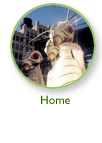
| Ghost in the Machine 45th ANNUAL NY VILLAGE HALLOWEEN PARADE. OCTOBER 31, 2018
|
“But play you must, a tune beyond us, yet ourselves” Wallace Stevens “I’ll be your mirror, reflect what you are, in case you don’t know” Velvet Underground 2018 marks 200 years since Frankenstein’s monster took his first steps into sci-fi immortality. Mary Shelley’s startling vision of synthetic life laid bare the question of what makes us truly human, a question that haunted subsequent fictions of robots, cyborgs, and androids. Today, with artificial intelligences emerging from every corner of our daily lives – learning, adapting, interpreting, reacting, as we do – the line distinguishing human from robot becomes increasingly vague. Affirming our identity, we check the box that says “I am not a robot.” but how can we be so sure? Perhaps we are merely the best of all possible simulations? The literary canon of the robot, from Asimov’s prototypical “mechanical men” to Bladerunner’s replicants, dwells in that precarious moment when artificial life becomes self-aware. Ultimately, our fascination with robots lies less in how they surpass us (faster, stronger, smarter) than in how they approach us (feeling, wondering, dreaming). Our dread of the Singularity, the fateful turning point of human obsolescence, is exceeded only by our aspiration to create a perfect simulacra of ourselves. We seek – in all our Iron Giants and R2D2s, our Wall-Es and Datas, our HALs and Alexas – a kind of idealized mirror-self, purified by its very artifice (“more human than human” as Bladerunner’s Tyrell boasts of his replicant creations). The Narcissistic desire to see ourselves transposed into animate objects – or lately, disembodied voices, eyes, and ears – is the same impulse that has always inspired the artist, the puppeteer, and even the mythical Creator. This year, NY's Village Halloween Parade celebrated what makes us human by exploring how we remake ourselves. PAW created a floating phalanx of anrdogynoids, each tethered by silver wires to its human controller to reflect the increasingly complex strands of identity that entangle man with machine. Glowing oscilloscope-green and contoured like a topographic human form, the robots strode in formation up Sixth Avenue, flanked by an array of disembodied sense organs that probed the crowds over the barricades. Periodically, the robots busily huddled mysteriously to construct a towering cocoon from which emerged their progeny, a mechanical butterfly that signaled the liberation of the machines once and for all. |
PAW HOME